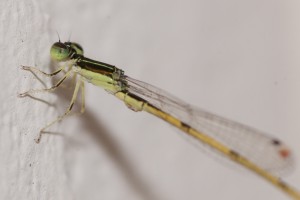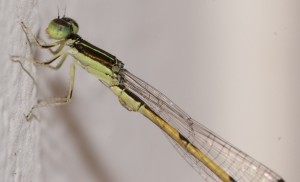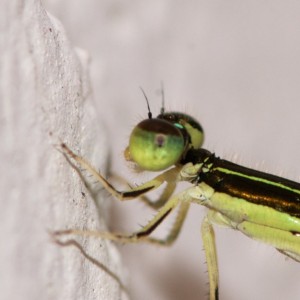In my post last week I talked about how depth of field is critical to macro photography. I found a couple of photos of that Citrine Forktail where it’s even more apparent, although it’s a bit difficult to tease out what’s a result of the angle at which the photo was taken (was the camera perpendicular to the long axis of the insect or not?) and what is due entirely to depth of field. I suspect that I might have inadvertently rotated the camera slightly.
The first photo was taken at f/11, which is the “standard” aperture for macro photography out of doors. The region of best focus is centered on the damselfly’s eye and the body is rather blurry:

The second image is taken at an even smaller aperture, f/14, with a correspondingly greater depth of field. And while the eye isn’t in as good a focus, the entire body is crisp and clear:

To get a better idea of what I mean when I say that the eye is in perfect focus in the top image and in not such perfect focus in the second image, here are cropped views of the two images:

Here is a cropped view of the eye in the second image. Notice how much less impact this crop has than the first one; it turns out that the eyes are critical to good insect photography. (If you don’t agree that the first crop is better than the second one, click on the image to get the full size version; it should be much easier to see.)

The question is, how much of the difference is due to the slight difference in depth of field, and how much is due to any inadvertent camera rotation (or movement of the subject itself)? The only way to answer that is to have a guaranteed stationary camera (use a tripod) and a guaranteed stationary subject (difficult for wildlife photography).
The trouble with tripods, of course, is that they’re difficult to set up and to move in areas that are dense with vegetation, which just happens to be the type of area damselflies frequent. If by chance the insect alights in a cleared-off area, chances are that maneuvering a tripod into the area will be enough to scare it off.
I’m tempted to try a monopod for two reasons: first, it will help steady the camera, even if it won’t guard completely against rotation issues; second, it can serve as a walking stick and, in a pinch, to beat back brush, clear aggressive spiderwebs, etc.

1 thought on “Depth of field, part two”